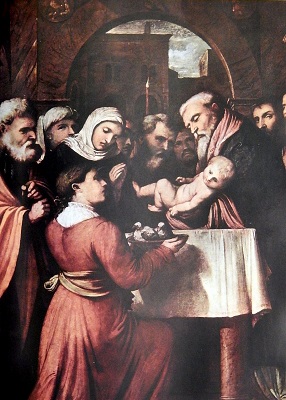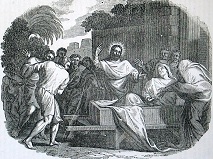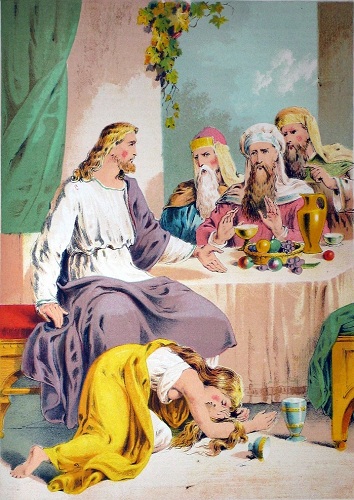Daily Bible Study Tips –
Luke 1:5-20 (2007)
Today we read about the messenger who will precede the Messiah, who turned out to be John the Baptist. John was so important that an angel appeared to his father to announce the forthcoming birth. This was the first of six angel appearances connected with the coming of the Christ child. Would you like to meet an angel? The first thing they ever say is "Don't panic!", so they must be pretty scary. We see in today's reading that they are sometimes short-tempered. Groups of angels are called "hosts" several times in the Bible; a host is an army. "Angel" means "messenger," but sometimes angels also have guard duty (e.g., outside the Garden of Eden) or serve as combat troops (as in Revelation). See also Malachi 3:1
Luke 1:26-38
An old rabbinical saying has it that God created the world in six days, and since then He's been making marriages. What was the Messiah doing in Nazareth? Well, that's where his mom and dad lived. Why did Joseph, a lineal descendant of David, live in Nazareth instead of Bethlehem? Obviously, because that was where Mary lived. Jewish men in the first century could relocate their homes and businesses, but unmarried young women couldn't. So when God made the marriage between Joseph and Mary, he had to move Joseph to the right town to meet her parents. Why Mary? Look at vs. 38. Everyone with that attitude will be chosen by God for great works, no matter when or where they live.
Luke 1:39-45
After Gabriel visits Mary and tells her that Elizabeth is pregnant and that she, Mary, will be pregnant, Mary dashes off to see Elizabeth. John Wesley says that the city Elizabeth lived in was probably Hebron, which belonged to the house of Aaron (see vs. 1:5). The distance between the two towns is about 20 miles, or two days journey. Mary stayed there about three months; probably she went back home after the birth of Elizabeth's baby, John.
Luke 1:47-55
I'll bet you already knew that Jesus and John were cousins – second cousins at least, because Mary and Elizabeth are also called cousins. When Mary came to visit Elizabeth, John leapt in the womb at the sound of her voice. When Elizabeth told Mary what had happened and blessed her, Mary sang this song. (Well, she may have just said it, but it's called "The Song of Mary.")
Luke 2:1-20
I have a beautiful crèche that my sister made for me in 1976. It has, in addition to the people, an ox, an ass, 2 camels, 2 sheep, a lamb, and a goat. Quick! How many of these animals does the Bible say were present around the manger?
Answer: None. The only animals mentioned at all are the flocks, which the shepherds left in the field in their hurry to see the child.
Luke 2:22-40
Joseph had to take Mary and the baby boy Jesus to Jerusalem 40 days after the birth so that Mary could be purified (Lev. 12:2-6) and Jesus, their firstborn son, could be redeemed (Ex. 13: 2, 13). The offerings for purification and redemption are specified; a pair of turtledoves or young pigeons was the prescribed offering for the poor. In the Temple they met a very old, devout man named Simeon. You have probably seen the sign that says, "God put me on Earth to do certain things, and right now I'm so far behind that I'll never die." God had told Simeon that he would not die until he had seen the Messiah. After he sees the baby Jesus, Simeon says, "God, now I can die in peace, because I have seen your salvation."
Random Walk in a Gallery of Religious Art, Step 40: Luke 2:21-35, Jesus presented at the Temple, by Romani Girolamo (7/24/15)
|
Romani Girolamo shows us a tender picture of Simeon as he holds the infant Jesus when Joseph brings Mary and the baby to the Temple to be purified. Two items catch my eye. One is that Joseph, as usual, is depicted as an old man. This has been the tradition of the Church for a long time, but you should know that the scripture doesn’t say he’s old. Joseph is never mentioned after Jesus is 12 years old, so apparently Joseph died, but that doesn’t mean he was old. The second item is more important: the two turtledoves. Any family who could afford a lamb had to bring a lamb and either a dove or pigeon. Only those who couldn’t afford a lamb could bring two pigeons or turtledoves. Since Joseph had a good business as a carpenter, I take this as another indication that he was a young man, just starting out in life, and that he and Mary were still poor when their first child was born. But if you disagree, that’s okay and puts you in the majority. Previous Step. Next Step. |
 "Jesus presented at the Temple" by Romani Girolamo, from the Gamble family Bible, now in the private collection of Regina Hunter. Photography by Daryl Lee.
"Jesus presented at the Temple" by Romani Girolamo, from the Gamble family Bible, now in the private collection of Regina Hunter. Photography by Daryl Lee.
|
Luke, a well-educated man and a careful historian, sets the time of the beginning of John's ministry in considerable detail. According to Wikipedia, Tiberius Caesar was the second Roman Emperor; he ruled from the death of the first emperor, Augustus Caesar, in A.D. 14 until his own death in 37. This would put the beginning of John's ministry about A.D. 29. This is consistent with the rule of Pontius Pilate, who was the governor of Judea from A.D. 26 until 36. Herod Antipas was tetrarch from about 4 B.C. to about A.D. 39 and Philip from 4 B.C. to 34. Herod Antipas and Philip were two of the sons of King Herod (who ordered the murders of the babies in Bethlehem). Lysanias is not known from sources outside the Bible.
Luke 3:7-18
John the Baptist preached straight out of the Old Testament prophetic tradition. He brought a message of rebuke, threats, correction, and the promise of deliverance. Most people concluded that he was a prophet – at least – and they came out to him in throngs to repent and be baptized. John insisted that repentance doesn't mean saying you're sorry: you have to change your behavior.
Luke 3:23-38
This passage in Luke is closely related to 2 Samuel 7:1-11. In our OT passage, God promises to establish David's house forever. Note the play on the word "house." David wants to build a house for God, i.e., a temple, but God says, on the contrary, I will build a house for you, i.e., a dynasty. The Jews therefore knew that the Messiah would be a descendant of David. Both Luke and Matthew give the ancestry of Jesus, and they both trace Jesus' lineage back through David.
There are differences in the two lineages. Matthew goes back to Abraham, father of the Jews, and Luke goes back to Adam, father of all mankind. Matthew is writing more for Jewish Christians, and Luke is writing more for gentile Christians, so each writer starts with the appropriate forefather to include his target audience. Other differences can be accounted for because of varying translations from Hebrew to Greek – for example, the German surname Jaeger has come into English both as "Yager," which is how it sounds, and as "Hunter," which is what it means. Still other differences in the lineages have not yet been accounted for, although a number of ideas have been proposed by scholars. It isn't anything to worry about.
Luke 4:21-30
Do you have a red-letter edition of the Bible? These editions have the words of Jesus printed in red. I've never compared to see whether they all have the same words, but even if they do, you need to exercise a little caution when you're reading one of them. The manuscripts of the Greek New Testament don't have quotation marks, verse numbers, or chapter breaks. (For that matter, the earliest manuscripts don't even have spaces between the words.) There is a Greek word, hoti, that introduces a direct quotation. (It can also introduce an indirect quotation, but translators can almost always figure that out.) The tricky part is that Greek has no way of showing that direct quotation has stopped. It's clear below, when the subject changes to "they," that Jesus has stopped speaking. Many times in the book of John, however, it's difficult to tell where Jesus stops speaking and John starts explaining what he said. Scholars differ, but don't get excited about it: whether the words are from Jesus or from John speaking by the inspiration of the Holy Spirit, it is still the word of the Lord.
Luke 6:17-26
Have you ever gone to the 8:15 and 11:00 services on the same day? Did you hear the "same" sermon? The Sermon on the Plain (SP), from which today's scripture from Luke is taken, is similar to the Sermon on the Mount (SM, Matt. 5 - 7). Many commentaries and papers conclude that there was only one sermon, but when Luke recorded it, he took stuff out and put other stuff in, set it on the plain, and noticed one set of people in the crowd, and that when Matthew recorded it, he took different stuff out and put different stuff in, set it on the mount, and noticed a different set of people in the crowd.
Other than that, say these commentaries, there are very few differences, so obviously Jesus only preached one sermon. I can tell you (because I actually counted) that the SP comprises 30 verses, SM, 107. Of the 30 verses in SP, 73% are parallel to verses in SM (counting partial and similar verses). Of the 107 verses in SM, 23% are parallel to verses in SP. John said that Jesus did so many things that all the books in the world couldn't tell about them. Apparently one thing that Jesus did was preach similar sermons on different occasions. The important thing to remember is that commentaries and study tips are useful, but you shouldn't believe everything you read.
Luke 6:30, Reader Question
Luke 7:1-17
 |
On Monday we saw two examples of God's compassion for the childless widow. In one case, God gave a child to a barren woman. In the other, Elijah called on God to raise a dead child for his widowed mother. Is it any surprise that Jesus, when he happens across the funeral of a dead youth, raises him and returns him to his widowed mother? The people's response was "A great prophet has arisen among us!" When Jesus asked his disciples, "Who do people say I am?", naturally one of the responses was "Elijah." A centurion was a Roman soldier, leader of 100 men. This centurion loved the Jewish nation, and he had built them a synagogue. Probably the reason he sent his friends to speak to Jesus is that he |
Luke 7:36-8:3
Did you know that "Mary" and its variants is the all-time favorite girl's name in the western world? "Mary" was also a popular name in first-century Palestine, and six different Marys are known to us from the New Testament:
- Mary, the mother of Jesus;
- Mary Magdalene;
- Mary, the sister of Lazarus and Martha;
- Mary, the mother of James and Joses;
- Mary, the mother of John Mark; and
- Mary, who lived in Rome.
Luke 10:25-37 (5/12/09)
We saw yesterday that when the foreigners to whom Peter was preaching heard the Gospel, the result was that they spoke in tongues, and it was by this result that the early Church knew that they had believed and had been accepted by God. Jesus was also interested in results as an indicator of belief. Jesus said that is not enough to know the Law: you must also practice the Law. The twist in the story of the good Samaritan is that the people who know the Law are the priest and the Levite. The person who practices the Law is the Samaritan. It's easy for us to feel superior to the priest and the Levite, because they lived a long time ago and most of us don't know what their jobs were. And we have all known since we learned to talk that a "good Samaritan" is a person who helps people in emergencies.
You will better understand the parable Jesus tells if you think of the first man, in vs. 31, as a Catholic priest. The man in vs. 32 is on the staff of a Methodist church. The man in vss. 33-34 is a terrorist. Jews and Samaritans hated each other at worst and had no use at all for each other at best. We've heard the phrase "Good Samaritan" so often that we forget that this was a complete contradiction of terms for Jesus' listeners. In their eyes, there was no such thing as a good Samaritan.
The Law says you must love God and love your neighbor. Probably all of us, if asked, would say that we do. The question is, if our lives were examined, would our practices say that we do?
Luke 10:38-42
Sometimes in the daily emails I combine two verses into one little paragraph before sending out the scripture reading. Today I didn't do it, because I want you to take a look at vss. 41-42 of Luke 10 and vss. 14-15 of Ephesians 2. In each case, the verse numeration takes part of a sentence and sticks it into an adjacent verse. Often the beginning or end of a paragraph is in the previous or subsequent chapter. Occasionally a single passage is spread out over two or three chapters. What difference does it make? By following the verse and chapter breaks only, you might take a piece of scripture out of its context and completely misunderstand it. It's like the old joke about the man who needed guidance. He closed his eyes and pointed at a verse: "Judas went out and hanged himself." Puzzled, he pointed again: "Go thou and do likewise." Annoyed, he pointed again: "What thou doest, do quickly." Always make sure that you understand the context of what you read! See also Ephesians 2:11-22.
Luke 12:13-21
Back in the old days, when the Spirit of God rested upon a person, that person was called a judge (as in, the book of Judges). Typically the judge began as a military leader, but once that was over, the judge continued to judge the people until his or her death. In today's reading, a man comes to Jesus and asks for a judgment. The CEV says, "Who gave me the right...?" In other, more literal translations, Jesus asks, "Who made me a judge or a divider over you?" Notice that Jesus does not say, "I don't have the right" – in fact, in the book of John, Jesus several times refers to himself as a just and righteous judge. Rather he asks the man, and the crowd, to think about who gave him the right, already acknowledged, to give judgments.
Luke 12:32
Bob Dylan wrote a song about the second coming called "Are you ready?" The verses talk about the state of our souls and the events of Jesus' coming, and the refrain is "Are you ready? I hope you're ready." Dylan's song could be based on today's reading from Luke.
Copyright 2007, 2008, 2009, 2010, 2011, 2013, 2015, 2016 by Regina L. Hunter. All rights reserved.
The illustration showing the unknown woman washing Jesus' feet is from the Binns family Bible, now in the private collection of Regina Hunter.
Opinions expressed on this page are solely those of the author, Regina Hunter, and may or may not be shared by the sponsors or the Bible-study participants. Thanks to the Holy Spirit for any useful ideas presented here, and thanks to all the readers for their support and enthusiasm. All errors are, of course, the sole responsibility of the author.
Our Sponsors:
St. John's United Methodist Church, "Transforming Lives Through Christ."
2626 Arizona NE, Albuquerque, New Mexico 87110
St. John's Music Ministries now has a YouTube channel, bringing you free concerts and choral music. Check it out!
Traditional worship services are held Sundays at 8:15 and 11:00 a.m. in the sanctuary. Casual worship services are held Sundays at 9:30 a.m. in the Family Life Center. Jazz Vespers are held monthly on the second Saturday at 5:00 p.m. in the sanctuary. St. John's feels especially called to the worship of God and to the service of our neighbors through our music program.
Storm Dragon SoftwareTM
Ducks in a Row, Inc.
This website is supported in part by the generosity of Mrs. J. Jordan.
